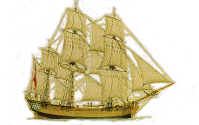Blue Ball Inn
The old dwelling at the northeast corner of Second and Market Streets was erected by Francis Richardson between the years 1765 and 1770. The land whereon it stands was devised to him in 1760 by Grace Lloyd. At the time he began the erection of this house Richardson believed he was on the high road to great business prosperity, but before he had finished it he became financially embarrassed, owing to mistaken efforts to advance Chester to the front rank as a commercial rival of Philadelphia. There were holes still in the brick walls until 1883, when the dwelling was repaired and modernized, where, when the house was building, the timbers were inserted on which rested the boards of the scaffolding. It is said by Martin that in the days before the Mechanics' Lien law, when masons were not paid for their work, these holes were always left in the wall to indicate to their fellow-craftsmen that default had been made in that respect, and no mason would fill them in until the builders' claims had been discharged. When the house was first built it was a noted inn, and from its peculiar sign — a blue ball suspended from the end of a pole or staff, which projected from a hole in the wall, in the gable-end on Market Street — it was known as "The Blue Ball Inn." Its then landlord was Samuel Fairlamb, who had married Hannah, the daughter of Francis Richardson. It was one of the dwellings struck by the balls from the English vessel of war which opened fire on the town in 1777, as narrated elsewhere, and the shot is said to have passed directly through one of the rooms in the second story.[bib]703[/bib]



